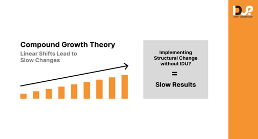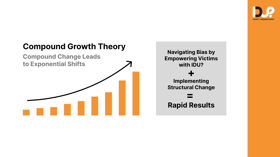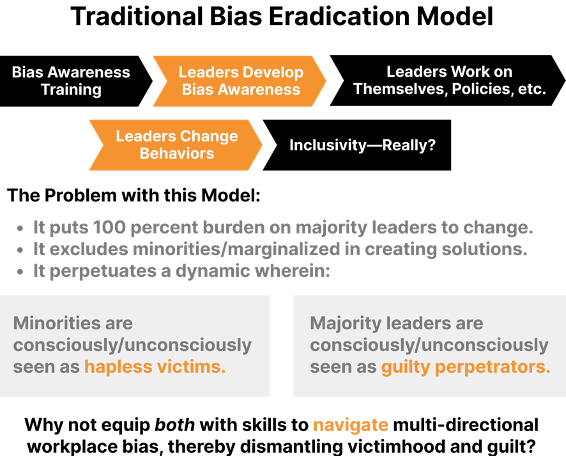Buki’s Big Idea
Great Leaders Recognize that Unconscious Bias is Not a One-Way Street
When it comes to tackling career-stifling and profit draining unconscious bias in the workplace organisations tend to follow one of four ill-fated unconscious strategies:
DNNS- Do Nothing Now Strategy- this is typically denying that there is a problem of career stifling unconscious bias, delaying doing anything at all or doing the bare minimum, that is just enough to tick boxes and give a veneer of caring one way or another. Such environments run the risk of low output, disengagement and deep unspoken tensions between majority and marginalised groups that could spill over in any moment.
DFTS- Do For Them Strategy- this is the most prevalent of the four strategies used by corporates. The problem is that it creates a ‘them and us’ or ‘us and them’ situation where the burden is on a presumed guilty majority leadership to create equal career opportunities for the presumed poor hapless minority/marginalised victims- both of these perspectives are unconscious biases in and of themselves. They also leave majority leadership in a perpetual state of self-correction and minority/marginalised groups in a perpetual state of reliance on the majority leadership for the advancement of their careers.
DWTS- Do With Them Strategy- this is the least common and most collaborative of the four unconscious strategies. Typically, it is characterised by allyship and collaborative DE&I initiatives to ensure equal opportunity for career progression. The problem with this strategy is that ultimate accountability for change still rests with the majority leadership.
DWAS-Do With Allies Strategy- this is typically a strategy that focuses on nurturing an environment of allyship that supports inclusion and equal opportunity. The only problem with this strategy is that it implies a need for allyship to counter the potential for inequity from the presumed guilty majority leadership. Again, sole accountability rests with majority leadership.
What's Wrong?
All four strategies have one thing in common: they are unidirectional. They are based on the premise that unconscious bias is a one-way street that starts and ends with majority leadership. They unconsciously subscribe to and perpetuate a corrosive ‘Guilty Perpetrator versus Hapless Victim’ mindset. To date these strategies have unconsciously contributed to painfully slow increases of minority representation in senior leadership roles as indicated below:
- 7 Black CEOs in the Fortune 500-1% Source- Forbes
- 50 Female CEOs in the Fortune 500- 10% Source -Forbes
- 1 FTSE100-listed business to have females in its top jobs: CEO, CFO, Chair Source -City AM
- 0 black chair, CEO or CFO in any FTSE 100 company. Source- Greenpark
- While accounting for 13% of professional positions at large employers, Asian Americans hold just 6% of senior management positions. - Source Goldman Sachs
- 6 CEOs across the FTSE 100 come from a minority ethnic background and 16 minority ethnic CEOs lead FTSE 250 companies Source-Parker Review
Great Leaders Adopt a Do-Together-Strategy
Buki shows how unconscious bias in the workplace is a two-way street. In other words:
There is a multi-directional nature to workplace bias
which requires a deliberate, Do-together-Strategy to harmoniously address the problem effectively and successfully ‘in the moment,’ when it is sensed, and where it has the potential to do so much damage. This is known as Bias Navigation and what Buki’s IDU? Methodology and keynotes address.
What Bias Navigation is not:
Spending inordinate amounts of time on:
- bias awareness training
- bias interruption training
- checking majority fragility
- checking majority privilege
- anti-‘isms’ policy and procedural change
What Bias Navigation is:
Accepting the multidirectional nature of workplace bias ‘in the moment’ and collectively learning:
so that through the law of compounding you can put ALL career-stifling and conflict generating bias behind you, your colleagues, your team, and organization once and for all.


“Little Drops of water, little grains of sand make the mighty ocean and the pleasant land”
Julia Abigail Carney, Little Things Poem
What Does a Successful Do-Together-Strategy Look Like When Implemented?
When correctly implemented a do-together-strategy is characterised by:
- Organisation-wide recognition that career-stifling unconscious bias in the workplace is a two-way street
- All staff equipped to effectively navigate unconscious workplace bias when sensed in the moment
- Managers/leaders equipped to effectively navigate sensed misinterpretations of unconscious bias attributed to them in the moment
- All staff feeling equipped to harmoniously navigate career stifling unconscious bias if they ‘sense’ it, using the IDU? Methodology
- Periodic bias navigation surveys that assess the extent to which ALL staff feel equipped to navigate multidirectional workplace bias
What’s the Payoff?
Dozens of studies have found that diversity of all kinds is good for business. When you equip an organisation's people with bias navigation skills you catalyse diversity and inclusion exponentially and organically increase minority representation in senior roles:
McKinsey: research shows companies with more gender diversity in their top teams are more profitable than average,
Morningstar: found companies with equal numbers of men and women on their boards achieved higher stock returns
Nazdaq: A medium-sized firm who appoints a Black executive will experience a 3.1% increase in market capitalization within three days of an announcement
Goldman Sachs: Despite representing less than 10% of the population, Asian Americans contributed $1.5 trillion in current dollar terms to the growth in gross domestic product.


